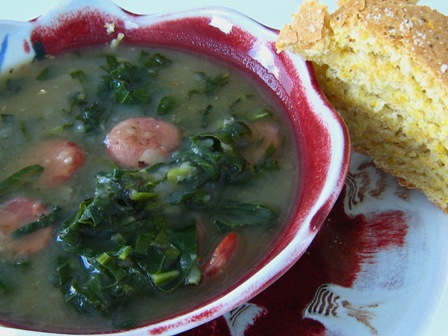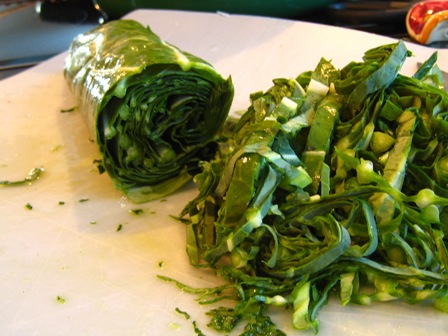SUNDAY SLOW SOUPERS #8 – CALDO VERDE
This week’s soup was chosen by Deborah of Old Shoes, New Trip. Deborah decided to choose a Portugese soup called Caldo Verde, or Green Soup. Her soup comes from Jean Anderson’s cookbook: The Food of Portugal. Here is the history of the soup, taken from pg. 97 & 98 of Jean’s book:
What makes this potato-thickened soup so green are hundreds of filaments of kale-like cabbage. According to Maria de Lourdes Modesto, star of a Lisbon television cooking show and author of the dazzling Cozinha Tradicional Portuguesa, what Portuguese women use for making caldo verde is the intensely green Galician cabbage (couve gallego), which has large, flat, tender leaves. At country markets you see women stacking the leaves, rolling them into fat “cigars,” then shaving them into the finest of shreds by whisking razor-sharp knives back and forth across the rolls at breathtaking speed. At more modern markets, like Lisbon’s Mercado da Ribeira, rolls of cabbage are fed into giant hand-cranked shredding wheels, each with a plastic bag at the back to catch the flying bits. If Portugal has a national dish, it is without doubt this lusty green soup, which originated in the Minho Province but now bubbles on stoves everywhere regardless of the season or temperature. To be truly authentic, each serving should contain a slice of salpicão (cured loin of pork) or chouriço (garlicky sausage). Obviously, because these Portuguese ingredients are often unavailable here, some concessions must be made. Collards, kale or turnip greens, I’ve found, make a good substitute for the Galician cabbage; spinach may be used in a pinch; even mustard greens, provided you shave them fine enough to cook quickly. As for the sausage, use a Spanish chorizo or Italian pepperoni if the Portuguese chouriço is unobtainable.
I was looking forward to this soup because I hadn’t tried a soup like it before-mashed potatoes in the soup and greens? Sounded pretty good. And it was. I started off by visiting a local butcher who carries some various sausages. I was planning on buying chorizo, as I was sure I wouldn’t find Portugese sausage. But guess what-sitting in the cases were packages of Portugese sausage. They told me they had just made it. So you start out making this soup by sauteeing onions and garlic, then adding sliced potatoes. Here’s a photo of the mixture cooking.
Then add water and cook until the potatoes are mushy. While the potatoes are cooking, you fry the sausage, then drain well. I think I learned one thing here-don’t drain the sausage too much. I placed it on papertowels, then pressed on the top with paper towels to extract every amount of fat I could. It was still very flavorful then, but after it was added back into the soup, it lost it’s flavor. So not as much draining next time. Anyway, after the potatoes are mushy, you get a potato masher and mash them right in the stock pot. Then you add the sausage, the greens, and simmer.
Jean describes above the slicing of the greens, here is a photo of mine. This photo shows turnip greens-I used a combination of turnip greens and kale.
The soup was very good and filling. I would have liked a little more flavor, and next time would use a broth and not water as the base. I’m getting ready to have another bowl of it as soon as I finish typing this.
Deborah also noted that this soup is usually served with chunks of Broa. Broa is a heavy yeast-raised corn bread from Northern Portugal. So I did a search on the internet, and found a recipe by Tyler Florence on Foodtv.com. The bread was perfect with the soup. Easy to make, dense, and again, filling.
Caldo Verde
Makes 6 to 8 servings
1 large yellow onion, peeled and minced fine
1 large garlic clove, peeled and minced
4 tablespoons olive oil
6 large Maine or Eastern potatoes, peeled and sliced thin
2 quarts cold water
6 ounces chouriço, chorizo, pepperoni, or other dry garlicky sausage, sliced thin
2½ teaspoons salt (about)
¼ teaspoon freshly ground black pepper
1 pound collards, kale, or turnip greens, washed, trimmed of course stems and veins, then sliced filament-thin. (The easiest way is to stack 6 to 8 leaves, roll crosswise into a firm, tight roll, then slice with a very sharp knife.)
Sauté the onion and garlic in 3 tablespoons of the oil in a large heavy saucepan 2 to 3 minutes over moderate heat until they begin to color and turn glassy; do not brown or they will turn bitter. Add the potatoes and sauté, stirring constantly, 2 to 3 minutes, until they begin to color also. Add the water, cover, and boil gently over moderate heat 20 to 25 minutes until the potatoes are mushy. Meanwhile, fry the sausage in a medium-size heavy skillet over low heat 10 to 12 minutes until most of the fat has cooked out, drain well and reserve.
When the potatoes are soft, remove the pan from the stove and with a potato masher, mash the potatoes right in the pan in the soup mixture. Add the sausage, collards and simmer uncovered 5 minutes until tender. Mix in the remaining tablespoon of olive oil, and taste the soup for salt and pepper. Ladle into large soup plates and serve as a main course accompanied by chunks of Broa.
Portugese Corn Bread – Broa
Ingredients:
2 packages active dry yeast
2 teaspoons sugar
1/4 cup warm water
1 1/2 cups stone-ground cornmeal, plus additional for sprinkling
2 teaspoons salt
1 cup boiling water
1/4 cup (1/2 stick) unsalted butter, melted and cooled
2 cups all-purpose flour, plus more for dusting
Extra-virgin olive oil, for brushing
1 tablespoon coarse salt
Directions:
In a small bowl combine the yeast, sugar, and the warm water in a large bowl until the yeast is dissolved and foamy, about 5 to 10 minutes.
In a large mixing bowl, combine the cornmeal and salt with the boiling water. Beat vigorously with a wooden spoon to blend. Add the melted butter and mix to incorporate. Now, pour the yeast mixture into the cornmeal mixture, stirring to combine. Gradually add the flour, mixing well after each addition. Add a couple of tablespoons of water if the dough feels dry and doesn’t come together easily. Continue to mix until a dough forms into a ball. Turn the dough out onto a lightly floured surface and knead, adding just enough flour to keep the dough from sticking, until smooth and elastic, about 5 to 10 minutes.
Grease a large bowl with oil and transfer the dough to the bowl, brush the top with more oil so it is completely coated. Cover the dough with a kitchen towel and let it rise in a warm place until doubled in bulk, about 11/2 hours.
Turn the dough out onto the floured surface and knead briefly, 3 or 4 times, to punch out the air. Gather the dough into a ball and shape it into a round loaf. Cover the dough with a kitchen towel and let rise again until doubled in bulk, about 1 hour.
Preheat the oven to 400 degrees F. and place a pizza stone in the oven to heat up.
Put the dough round on the pizza stone and brush the top with oil. Sprinkle the top of the bread with coarse salt. Bake in middle of the oven for 40 to 50 minutes until the bread is golden brown and bottom sounds hollow when tapped. *To recreate the steam effect from authentic Portuguese brick ovens, spray the bread and oven walls with cold water every 10 minutes. Transfer the bread to a wire rack to cool.




I love this soup. I used to make it all the time but haven’t for years. Thanks for reminding me!! It’s definitely soup weather, BRRRR! Yeasted corn bread is a new one — it lookds and sounds very interesting.
Cindy, I agree with you about using broth instead of water next time. Love your picture of your greens.
I guess I’m going to have to try the Broa, if you and Jerry did. Gotta keep up you know.
Your pictures are great, Cindy! And the broa looks delicious – I need to try that!